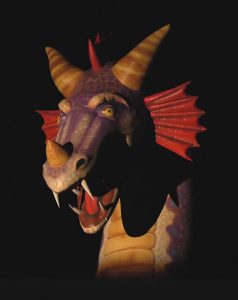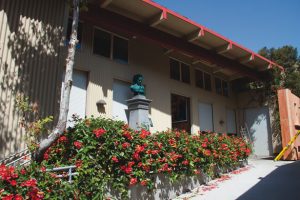Technology complements art, helping bring genius to the Pageant of the Masters. – By Vicki Hogue-Davies
It takes true genius to create art that lives through the ages. That exceptional creativity and talent come vividly to life during the 2012 Pageant of the Masters, themed “The Genius,” which celebrates “the power, strength and intelligence inherent in masterful works of art,” says pageant director Diane Challis Davy. The show highlights old masters such as Michelangelo and Vincent Van Gogh, explores scientific innovation with a segment on the stars of astronomy, celebrates legendary composers through etching and sculpture, and more. “We even have a segment on the Titanic and what happens when genius turns into hubris,” Diane says.
As the masters celebrated in this year’s show used the technologies of their time in art, so have pageant organizers used technology to enhance the living pictures that showcase the artists’ works. Just as art has been shaped by time and technological changes, so has the Pageant of the Masters been shaped and changed during its nearly 80 years of displaying art through living pictures.
Presenting the Pageant
“Much has been made about the living pictures presentation as part of the Festival of Arts program in 1933, but that first presentation was truly primitive,” says Dan Duling, pageant scriptwriter for the past 31 years. The first “tableaux vivant” presentation, squeezed in between other stage performances, was described by Roy Ropp, a local builder of the time, as “basically looking like a rolling outhouse on stage with a single figure wearing a thrift store costume trying to look like a living picture,” Dan says. “Ropp objected to the presentation because he felt it was very amateurish and insulting to the master works of art and the value of art, especially in an artist’s colony. He felt it should be done with more regard and respect for the masters,” Dan continues.
 Roys’ criticism drew the attention of the festival board, who said, “ ‘If you think it can be done better, you are in charge,’ ” Dan adds. “In 1935, with the help of his wife, Marie, Ropp took the pageant to the earliest stages of being a top production.” Roy designed and built a stage, created a frame for the stage and put on a 45-minute show featuring live narration and live music, and a curtain that pulled back to reveal the living pictures. The backgrounds were even hand-painted by Roy.
Roys’ criticism drew the attention of the festival board, who said, “ ‘If you think it can be done better, you are in charge,’ ” Dan adds. “In 1935, with the help of his wife, Marie, Ropp took the pageant to the earliest stages of being a top production.” Roy designed and built a stage, created a frame for the stage and put on a 45-minute show featuring live narration and live music, and a curtain that pulled back to reveal the living pictures. The backgrounds were even hand-painted by Roy.
In the beginning, the festival and pageant moved to different downtown locations each year. “The women’s club downtown had a grove of eucalyptus, and Ropp makes written reference to his electrician filling those trees with strings of lights,” Dan says. “That would have been roughly in 1937. It was already becoming an evening performance with some semblance of lighting.”
In 1941, the festival and pageant move to their permanent location at the Irvine Bowl where a stage could be built—a move that Dan describes as the next major step technologically for the pageant.
Circa 2012
Stepping forward to the technology of 2012, lighting up the night sky over Laguna this year will be lasers highlighting “The Stars of Astronomy.” The segment is a tribute to artwork that depicts Galileo, Copernicus and other revolutionary astronomers. Lasers were also used in the 2001 show, notes Diane, but “laser technology has improved over the decade, and this year’s show will use more and better lasers.”
As technologies improve, pageant organizers try to keep pace. However, it is not a case of using “technology for technology’s sake.” More modern tools are only used where they enhance the production, and many things are still done the old-fashioned way, by hand.
“We want to keep up and be cutting edge, but we have such a tradition of how we do things, such as painting by hand and everything being live,” says Butch Hill, technology director. “We don’t want to take that uniqueness away by doing too much technology, so we use it to our advantage.”
Every few years, lighting and sound systems are upgraded. A big change this year is the use of LED lights rather than incandescent lamps, which will allow for better control of color and brightness. A high-definition projection system was purchased last fall.
Advances in sound design this year include a new speaker system, called a “line array,” made by the French firm L-Acoustic. The system distributes sound more evenly and sends sound farther than previous systems. “I think it is the same system that is used at the Hollywood Bowl,” Butch notes. The system is designed to enhance the sound of the live narrator, the video and film clips, and the live orchestra. Always a hallmark of the pageant, the live orchestra was replaced by records in 1950 in a cost-cutting move.
“A lesson was learned that summer that records shouldn’t be part of the pageant,” Dan says. “The hue and cry that came out of using canned music to go along with each tableaux was intense and negative. There was a memorable review in a local publication that described the speakers feeding back and the scratching sound so disruptive to the mood of the pageant that it became a point of ridicule.”
Painting of sets and backdrops is still done by hand as it was in Roy’s time, but the tools used to make painting easier have been modernized.
“Over the years, one of the biggest upgrades we’ve done is the construction of our shop facilities, our studio out back behind the stage,” Butch says. “We have state-of-the art shop areas with modern machinery. We used to have a homemade kind of ‘paint bridge’ that would go up and down on a counterweight system to lift people up to paint backdrops. Now we have two really nice scissor lifts bolted to the floor, which makes it easier and safer to paint.”
Computer Generated
Computers, introduced to the pageant during the 1980s, have made it easier to design sets and draft patterns for costumes. The technology has also allowed for the increased use of short documentary films about the artists that are shown throughout the pageant.
“Computers are also a big assist with technical matters unseen by the audience,” Diane says. “We use computer drafting for set design. They help us size and rescale paintings into set designs that accommodate people.”
Computer drafting also helps with costume making. Seven years ago, Mary LaVenture, costume/headpiece designer, introduced patternmaking software. “Costuming is made easier by using computers for drafting patterns,” she says. “Prior to computers, we drafted everything by hand.” She adds, “We still do that sometimes if we are doing something that is historical, like an 18th century gown, for example, because a modern pattern wouldn’t necessarily mimic 18th century construction.”
Diane notes that after the turn of the 21st century, “We started making our own films in house. It is fun and creative work thanks to the computer programs that allow us to do our own editing. We interweave the films into the program to impart a lot of information in a fun and entertaining way.” Under her term as director, which began in 1996, videos were introduced to the show, replacing slide projectors.
Moving Pictures
 Pageant actors seek to keep as still as possible, and steel armature hidden behind actors who are in more precarious positions helps keep them still and safe. Armature for sculpture is the framework around which pieces are built. “We have armature of our own technology—hidden as best we can and bent to the shape of the body,” Butch says. “The actors have some kind of safety belt that snaps into it.”
Pageant actors seek to keep as still as possible, and steel armature hidden behind actors who are in more precarious positions helps keep them still and safe. Armature for sculpture is the framework around which pieces are built. “We have armature of our own technology—hidden as best we can and bent to the shape of the body,” Butch says. “The actors have some kind of safety belt that snaps into it.”
While actors stay still, sometimes technology is employed to make things move. “We do revolve things now and then to show off all four sides if it is a particularly interesting sculpture,” Butch notes. The mechanical stage revolves with motor controllers, chain drives and other technologies to keep art turning. Sometimes remote control operators are responsible for different moves.
For example, during the 2011 show, three dragons breathed fire at each other to the delight of the audience. Three radio control operators made their wings and heads move, and their jaws open to blow out smoke and fire. Where did the smoke and fire come from?
“We used a lighting effect combined with carbon dioxide smoke,” Butch says. “There were dragons on each hillside and one on the roof that was an inflatable. The two on the hills were like very large puppets made of steel, wood, Styrofoam and other things. Their eyes also lit up. We used curved lenses that looked like eyes with lights behind them.”
Another moving part is the turntable stage. During Diane’s tenure, it has seen full use, Dan says, noting that the prior director didn’t trust it. “The turntable stage is a wonderful asset, and I haven’t seen any problems with it. Since Diane took over as director, she has really taken every opportunity to keep the show moving and flowing, to keep the pace of the show going and the number of stops down to a minimum.”
He adds that the Pageant of the Masters, with its old-fashioned hard work coupled with use of technology, gives people more time to look at artwork than they might if walking by it at a museum, and with narrative and video they make more of a connection. “This notion of costuming people and putting them into sets, it engages people in a way they might not have expected to be engaged,” he says. “We are perfecting 3-D into 2-D while Hollywood is perfecting 3-D.” LBM








